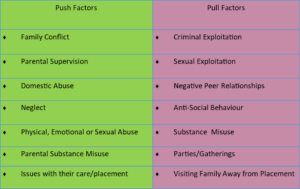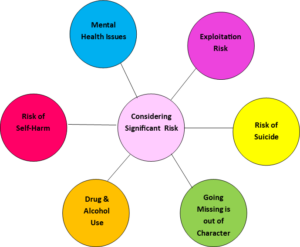Exploitation
If you are concerned a child or young person is being criminally or sexually exploited you MUST report it.
Exploitation is a Key Priority in Walsall, therefore the following have been produced:
- All Age Exploitation Reduction Strategy
- Access the Assessment Tool and further information on Walsall Pathways, Procedures and Guidance
- Access the WMP Partnership Form (FIB)
- View the WM Police Force Intelligence Bureau (FIB) Multi-Agency Information Sharing Video
- View the Exploitation Assessment Tool and Pathway Webinar
Child exploitation (CE) is when a child or young person is tricked or forced into doing something sexual or criminal seemingly in return for things like love, affection, money, drugs or alcohol.
Definition of Child Sexual Exploitation
Child sexual exploitation is a form of child sexual abuse.
It occurs where an individual or group takes advantage of an imbalance of power to coerce, manipulate or deceive a child or young person under the age of 18 into sexual activity (a) in exchange for something the victim needs or wants, and/or (b) for the financial advantage or increased status of the perpetrator or facilitator.
The victim may have been sexually exploited even if the sexual activity appears consensual.
Child sexual exploitation does not always involve physical contact; it can also occur through the use of technology.
(Department for Education, 2017)
Both grooming and sexual exploitation can happen in real life and online. In fact, online contact often plays a big part in sexual exploitation.
Definition of Criminal Exploitation (also known as ‘county lines’)
County lines is a term used to describe gangs and organised criminal networks involved in exporting illegal drugs into one or more importing areas within the UK, using dedicated mobile phone lines or other form of “deal line”. They are likely to exploit children and vulnerable adults to move and store the drugs and money and they will often use coercion, intimidation, violence (including sexual violence) and weapons.
(Home Office, 2018)
Sometimes things that seem like normal teenage behaviour could be a sign a young person is being sexually and / or criminally exploited. It should be noted that child sexual and criminal exploitation can also occur without any risk factors or signs being obviously available.
Signs which may indication Child Sexual Exploitation
- Acquisition of money, clothes, mobile phones etc without plausible explanation
- Gang-association and/or isolation from peers/social networks
- Exclusion or unexplained absences from school, college or work
- Leaving home/care without explanation and persistently going missing or returning late
- Excessive receipt of texts/phone calls
- Returning home under the influence of drugs/alcohol
- Inappropriate sexualised behaviour for age/sexually transmitted infections
- Evidence of/suspicions of physical or sexual assault
- Relationships with controlling or significantly older individuals or groups
- Multiple callers (unknown adults or peers)
- Frequenting areas known for sex work
- Concerning use of internet or other social media
- Increasing secretiveness around behaviours
- Self-harm or significant changes in emotional well-being
(Department for Education, 2017)
Signs which may indication Child Criminal Exploitation
- Persistently going missing from school or home and / or being found out-of-area
- Unexplained acquisition of money, clothes, or mobile phones
- Excessive receipt of texts / phone calls and/or having multiple handsets
- Relationships with controlling / older individuals or groups
- Leaving home / care without explanation
- Suspicion of physical assault / unexplained injuries
- Parental concerns
- Carrying weapons
- Significant decline in school results / performance
- Gang association or isolation from peers or social networks
- Self-harm or significant changes in emotional well-being
(Home Office, 2018)
Contextual Safeguarding is an approach to understanding, and responding to, young people’s experiences of significant harm beyond their families. It recognises that the different relationships that young people form in their neighbourhoods, schools and online can feature violence and abuse. Parents and carers have little influence over these contexts, and young people’s experiences of extra-familial abuse can undermine parent-child relationships.
As a critical part of safeguarding practices, Children’s social care practitioners, child protection systems and wider safeguarding partnerships need to engage with and assess the individuals and sectors who do have influence over/within extra-familial contexts and where necessary provide intervention. Contextual Safeguarding expands the objectives of child protection systems recognising that young people are vulnerable to abuse beyond their front doors.
https://contextualsafeguarding.org.uk/
This website provides an overview of the Contextual Safeguarding Research Programme, including its history, vision and mission, team, current suite of projects, and key publications. To access the policy and practice resources created through this programme, and hear from practitioners and decision-makers who are using a Contextual Safeguarding approach in response to abuse in extra-familial settings please visit the virtual hub of the Contextual Safeguarding Practitioners’ Network on www.csnetwork.org.uk
The Home Office Child Exploitation Disruption Toolkit provides an overview of disruption tactics for those working to safeguard children and young people under the age of 18 from sexual and criminal exploitation.
Adolescents who go missing are at greater risk of physical abuse, grooming and Sexual Exploitation.
Going missing can be a warning sign of a range of serious harms including sexual and criminal exploitation; bullying; mental health issues; and unhappiness in the home. Looked after children may also go missing because they want to spend time with their family or in their home area if they have been moved away to a placement.
There are also risks to reporting a child to the police as missing inappropriately. Research has shown that over-involving the police in a child’s life, including by reporting them missing unnecessarily, can cause significant harm and can damage the child’s relationships with the professionals around them.
There are a range of push and pull factors that might cause children to go missing which have been identified by young people:

What professionals should consider when deciding what to do
- Be sensitive in both contacting the child, and in any contact with their friends or friends’ families.
- When contacting the child ensure that they do not feel pressured or blamed.
- When contacting their friends, they should allow the missing child some privacy and not single them out for being in care.
- Get to know the child to understand how best to support them and ensure the most appropriate response if go missing.
Contacting the police is a moment of escalation and therefore it is important to use other options to contact the missing child or facilitate their return first, unless the circumstances suggest there is an immediate risk.
Where there are thought to be significant risks for the child a missing episode should be reported to the Police for example:

It is important to understand the reasons a child goes missing. What are the things going on in their life that might mean it is more important to report them missing to the police if no one knows where they are?
Exploitation Posters are available to download. There are two posters one for professionals and one for community use.
For more information visit the Regional Child protection Procedures 2.19 Children missing from care, home and education.
The WSP multi-agency training programme includes courses on Exploitation.
Guidance for Professionals – Appropriate Language Child Exploitation
Please use this Slang Dictionary which seeks to support parents, carers and professionals to better understand the language young people may be using and support them to safeguard young people.
- Street Teams – Walsall’s local provider for young people and their families at risk or and abused through Exploitation.
- Barnardos– Barnardos is the largest provider of child sexual exploitation support services in the UK. This page provides information on the work that they do and links to their own research and resources relating to CSE.
- The Child Exploitation & Online Protection Centre (CEOP) – CEOP works with child protection partners across the UK and overseas to identify the main threats to children and coordinates activity against these threats that bring offenders to account.
- The Children’s Society – Outlines the policy work of the Children’s Society in relation to CSE, criminal exploitation, trafficked young people, including their latest research.
- Crimestoppers – Campaigns including tackling CSE and county lines.
- Gov.uk – Guidance for frontline professionals on dealing with county lines, part of the government’s approach to ending gang violence and exploitation.
- Local Government Association Child Sexual Exploitation Resource Page – Links to resources, national guidance and action plans
- National Crime Agency – Briefing report about county lines, violence, exploitation and drug supply.
- NSPCC – Information research and resources on child abuse including CSE and trafficking.
- Ivison (formerly PACE) – Ivison works alongside parents and carers of children who are being, or are at risk of being, sexually exploited by perpetrators external to the family.
- Exploitation | Saferwallsall (saferwalsallpartnership.com)
